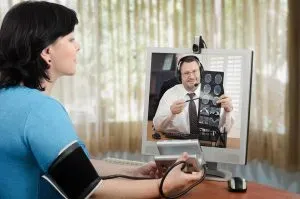 The standard operating procedure for getting medical has long been physically going to a doctor’s office or, in rare occasions, you might still get a house call. But with the advent of the Internet and video chat, the option of telemedicine is becoming more and more common.
The standard operating procedure for getting medical has long been physically going to a doctor’s office or, in rare occasions, you might still get a house call. But with the advent of the Internet and video chat, the option of telemedicine is becoming more and more common.
Telemedicine is the use of communications technology to provide a diagnosis or medical consultation, and it reaches back as far as the early 1900s when it was used to provide medical assistance to people in remote areas. In today’s context, people are turning to telemedicine to avoid the long waits typically associated with the average doctor’s visit, or in some cases, even the ER. And recent studies are pointing to telehealth visits as a viable way of reducing overall healthcare costs.
In New York alone, there were more than 6 million hospital visits in 2013. Out of these, over 2 million of these visits were for minor conditions such as cold, coughs, flu, sore throat, migraines, sinus infections, and ear infections — situations where a telehealth visit could have provided sufficient assistance at roughly 3% of the average cost of a trip to the ER. The burden on emergency health care staff would also have been eased if these cases were evaluated remotely.
Let’s take a closer look at what telemedicine offers:
Convenience and Access to Instant Medical Care
This is, by far, its biggest appeal. Long waits in the doctor’s office are aggravating to everyone involved, and many people know by now that they can’t expect to get in and out on their lunch break. Telemedicine offers some relief — allowing a patient to be evaluated promptly with little disruption to their routine. This benefit extends to people in more rural areas, who might not otherwise have easy access to medical advice. These people are able to use a smartphone or other device to have minor injuries and illnesses diagnosed immediately, and these telemedical services are even able to call in prescriptions like any other doctor.
Reduced Burden to both Patients and Healthcare Providers
The hours spent in hospital waiting rooms can be spent on something more productive if you could get your diagnosis quickly and on time. Imagine spending 2 hours in a dental waiting room just to get some pain relief meds for a recent procedure, when you can easily go online, get the prescription and meds in less than half the time you would spend at the clinic. And convenience aside, a patient with a respiratory infection, for example, could start an antibiotic regimen days sooner if they don’t have to schedule an in-person visit. Better still, it could prove to be far more cost-effective, as recent studies continue to indicate.
Use Cases for Telemedicine
Many patients have been saved from the repercussions of misdiagnosis because they got a second opinion. With telemedicine, all it might take is finding the right specialist and emailing them your MRI, Angiogram, or X-ray, along with your medical history, to confirm or conflict the initial diagnosis.
But telemedicine also comes with the potential for medical malpractice in the form of an inaccurate diagnosis – sometimes, conditions can present with similar symptoms and may require an in-person visit to properly diagnose. The potential for this kind of misdiagnosis varies wildly depending on the situation and circumstances, and care should be taken to consider whether telemedicine is an appropriate avenue. Likewise, telemedical practitioners have a responsibility to ensure that they refer patients they cannot effectively work with to the appropriate form of medical attention.
Telemedicine is not without substantial benefits, but both patients and healthcare workers must keep a careful eye on how this practice is applied.








